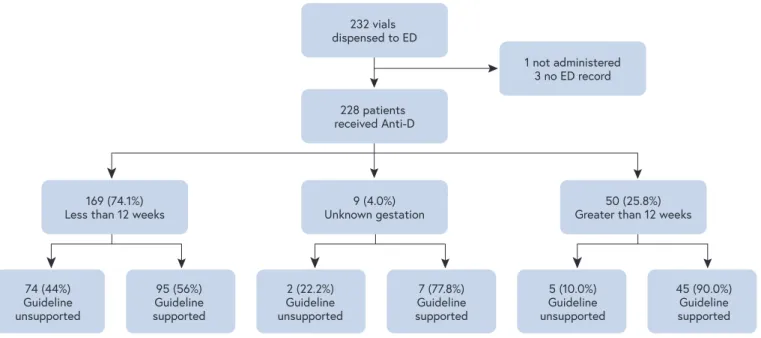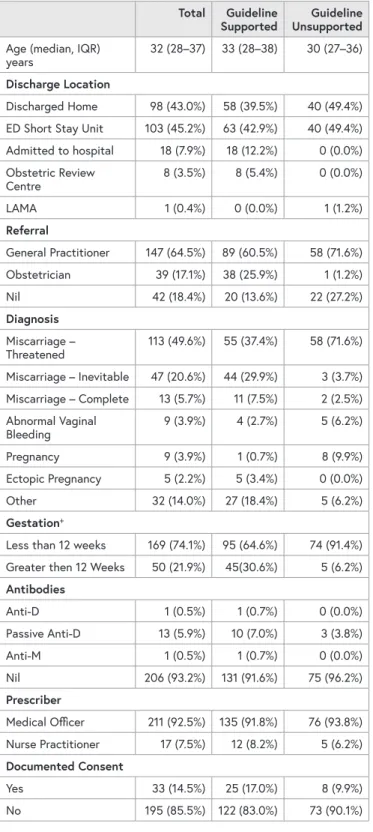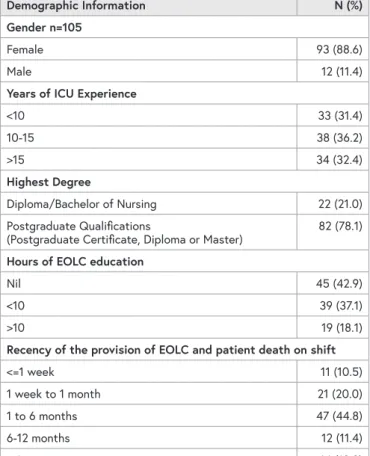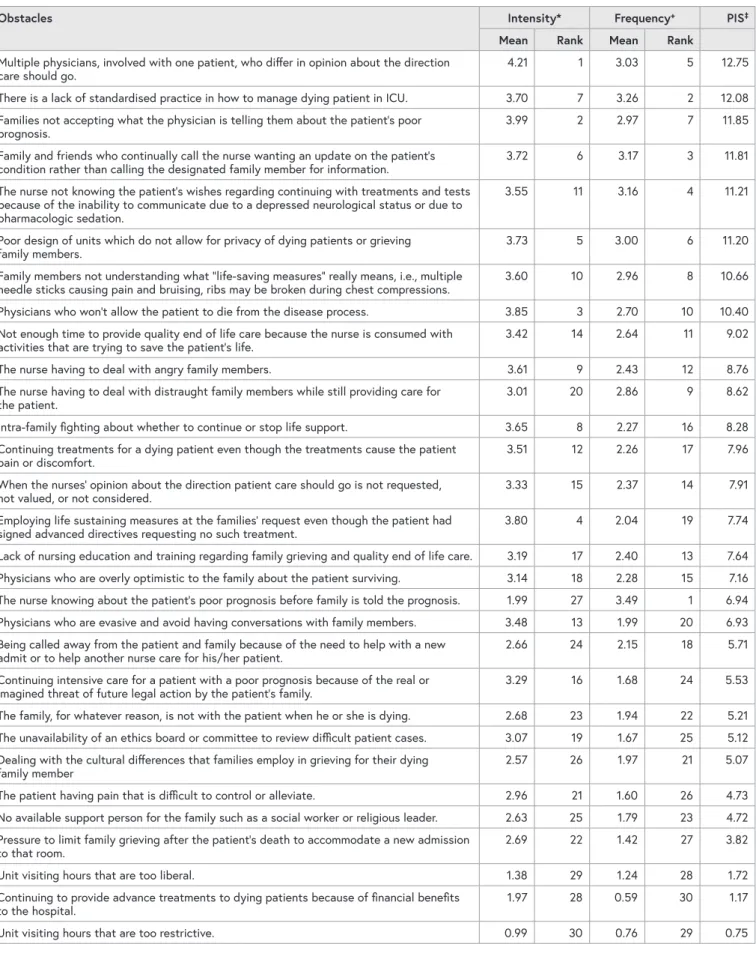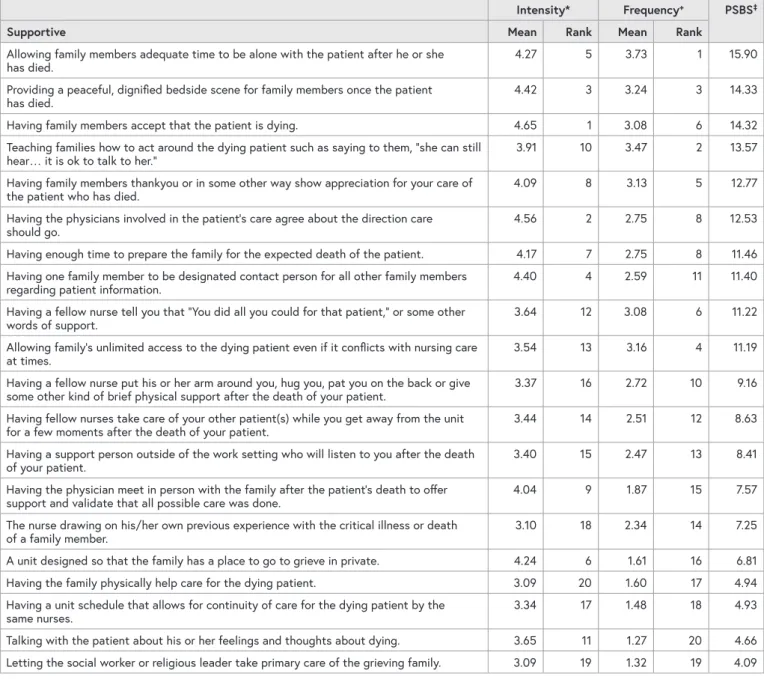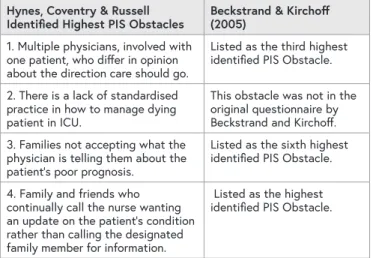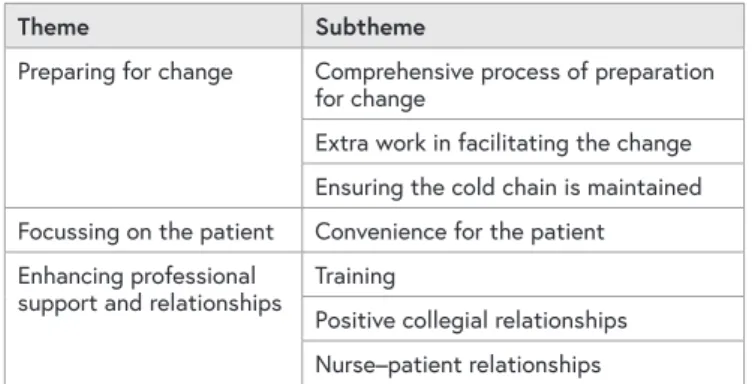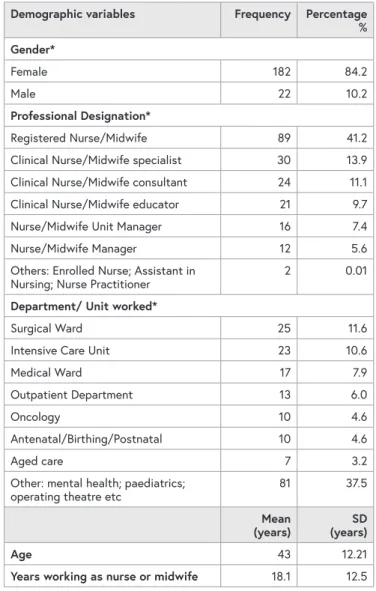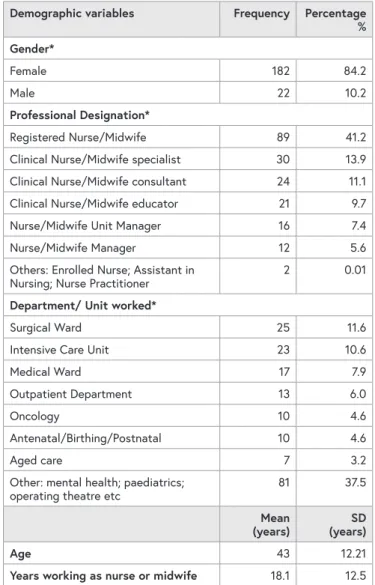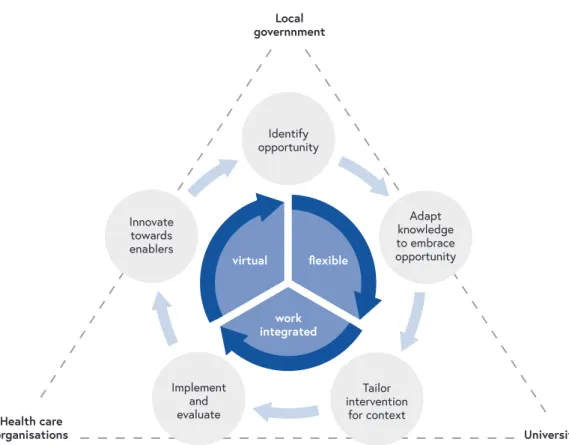An international peer-reviewed journal of nursing and midwifery research and practice
The Australian Journal of Advanced Nursing is the peer-reviewed scholarly journal of the Australian Nursing and Midwifery Federation (ANMF).
The Mission of AJAN is to provide a forum to showcase and promote a wide variety of original research and scholarly work to inform and empower nurses, midwives, and other healthcare professionals to improve the health and wellbeing of all communities and to be prepared for the future.
Publisher and Editorial Office: Australian Nursing and Midwifery Federation • Email: [email protected] • www.ajan.com.au
IN THIS ISSUE
EDITORIAL
Learning in the pandemic: a reflection.
Moroney T.
P. 1
•
2020.391.790RESEARCH ARTICLES
Emergency clinicians’ interpretation and application of Anti-D guidelines.
Schmidt M, Brownlie J, Arnold A, et al.
PP. 2–6
•
2020.391.316Intensive care nurses’ perceptions on barriers impeding the provision of end of life care in the intensive care setting:
a quantitative analysis.
Hynes L, Coventry T, Russell K.
PP. 7–17
•
2020.391.214Healthcare workers’ experiences of transitioning
natalizumab infusions from hospital services to an in-home setting: a qualitative study.
Juaton M, Cusack L, Schultz T.
PP. 18–26
•
2020.391.240It’s just not that easy! Challenges faced by nurses and midwives in the work environment in adhering to social distancing during COVID-19.
Hobbs C, Moxham L, Green H, et al.
PP. 27–33
•
2020.391.376Coronavirus disease 2019 Critical Care Essentials course for nurses: development and implementation of an education program for healthcare professionals.
Jarden R, Scanlon A, Bridge N, et al.
PP. 34–43
•
2020.391.423Learning in the pandemic:
a reflection
The impact of the COVID-19 pandemic on the health system has been well documented both in Australia and internationally. For nursing students, changes to course delivery, a move to remote learning, as well as the disruption to clinical and simulated learning opportunities have added to the stress experienced by communities affected by lockdowns and the COVID-19 illness. In addition, students feared delayed graduation, managing the academic workload, and greater stress from clinical placement.
In the beginning of the pandemic, the unknown and misinformation linked to COVID-19 heightened students stress and anxiety levels. Questions like; can I access PPE?
is my knowledge of infection control adequate? and can I bring home COVID-19 to my family? were common. Clinical placement, in particular, became for students a time of stress and concern, and this undoubtedly affected their learning and their developing confidence. Students, and those who governed clinical placements questioned whether it was appropriate to place them at this time. Clinical providers were unsure how to safely use students during the pandemic and placement cancellations started to rise. This placed stress on education providers who struggled to find appropriate learning experiences. These sentiments have been recognised internationally in wider research.1
While on-campus teaching moved towards remote delivery, learning in the clinical environment become haphazard and unpredictable. Clinical staff, who play a critical role in supporting student learning were unavailable because of the increasing complexity and workload of the pandemic.
Optimal learning was impacted, students were not exposed to opportunities to engage with and transform their experiences with healthcare staff. The clinical environment was not as welcoming and at times, students did not feel part of the team. Students often felt like a burden and during the pandemic,2 these feelings may have increased.
This might have left some students questioning their role in the profession and ultimately whether nursing was for them.3 In addition, students may have lacked opportunities to role model from experienced healthcare staff, as the staff themselves were pushed to exhaustion.
Despite the challenges, there were some unintended benefits.
After the initial months of the pandemic, students became increasingly flexible and were adept at studying remotely.
For some, their resilience grew, and they developed new ways of collaborating online with their colleagues. Opportunities arose for the placement of students; clinical and educational providers began to see the value of having students on
placement. Those students who assisted in the pandemic response reported feeling empowered and respected for their contribution. These students demonstrated greater motivation to deliver high-quality care, and this assisted in developing their confidence.4 Students were keen to play their part in the management of the pandemic. Many volunteered or sought employment in places such as vaccination hubs and this helped ease some of the pressure on front line staff. Industry and educational providers found new ways of working together and it is hoped that the lessons learnt during the pandemic might continue to shine a light on the value of the student contribution to health services.
The stress and anxiety from learning in high-risk environments cannot be underestimated. For the graduating class of 2021, almost two thirds of their degree was impacted. No doubt these graduates who are soon to join our profession, will question their work readiness. Just like other new graduates, the class of 2021 will need support and understanding as they transition and adjust to the work environment. This is especially important, as those who seek to support and assist with transition are themselves stressed and in need of care and compassion. In recent days, we have seen nurses and midwives take to the streets to promote safe working environments and we have heard from a number of experienced staff who are not able to go on. This is an international phenomenon.
There is no greater time for nurse leadership and the development of cultures where respect, flexibility and where we take the time to listen and support others than now.
Professor Tracey Moroney
Head of School, Curtin School of Nursing, Faculty of Health Sciences, Curtin University, Perth, Western Australia, Australia.
REFERENCES
1. Majrashi A, Khalil A, Nagshabandi EA, Majrashi, A. Stressor and coping strategies among nursing students during the COVID-19 pandemic: scoping review. Nurs Rep. 2021;11:444-59
2. Gerdtz M, Moroney T, Hatcher D, Williamson M, Maude P, Weller-Newtwon J, et al. Entry to practice programs in nursing:
contributions to learning, direct care and health systems.
Council of Deans of Nursing and Midwifery. 2021
3. Tee S, Yeter S, Üzar Ö, Russell-Westhead M. Workplace violence experienced by nursing students: a UK survey. Nurse Educ Today. 2016;41:30-5.
4. Cushen-Brewster N, Barker A, Driscoll-Evans P, Wigens L, Langton L. The experiences of adult nursing students completing a placement during the COVID 19 pandemic.
Br J Nurs. 2021;30(21):1250-5
ABSTRACT
Objective: The objective of this study was to audit the use of anti-D immunoglobulin (anti-D) against the current Australian guidelines in one large inner-city referral hospital over three years and critique the practice identified.
Background: Pregnant patients who have a D-negative (RhD negative) blood type are at risk of D alloimmunisation if a potentially sensitising event occurs during pregnancy or birth. The administration of anti-D Ig can prevent complications related to alloimmunisation. Potentially sensitising events commonly present to the emergency department requiring the administration of anti-D Ig in line with current guidelines.
Study Design and Methods: This is a retrospective cohort study of all patients who received anti-D Ig in a large inner-city emergency department (ED) over three years (July 2014 – June 2017). Indications for administration were scrutinised against current guidelines by experienced clinicians.
Results: A total of 228 patients received anti-D Ig, with the majority being less than twelve weeks in gestation (169, 74.1%). Anti-D Ig was administered without support from the guidelines in 81 (35.5%) patients, with a lack of documented sensitising event in 77 (95%) of these cases.
Discussion and Conclusion: There were
inconsistencies amongst clinicians who prescribe anti-D Ig in the ED, and a lack of the application of current guidelines. This may stem from a lack of empirical evidence about the need for anti-D Ig in the most common group presenting to EDs, those under twelve weeks in gestation. Current guidelines also fail to take into consideration future need, which could be incorporated in future, ED specific anti-D Ig guidelines.
Implications for research, policy, and practice:
This audit identified overuse of anti-D Ig in the ED. This may stem from the absence of evidence for its use in pregnant patients under 12 weeks in gestation. To reduce unsupported use, further data on alloimmunisation rates following potentially sensitising events in early pregnancy would be helpful. Additional guidelines specific to patients under 12 weeks in gestation, and presenting to the emergency department may reduce some unsupported usage.
What is already known about the topic?
• Pregnant patients who have an D-negative blood type are at risk of D alloimmunisation when a sensitising event occurs.
AUTHORS
MATILDA SCHMIDT BN MMid MNPracSt1 JULIA BROWNLIE BN MNurs MNursPrac MWomHMed11
AMY ARNOLD BSc MBBS FRANZCOG2,3 KIM LAI MBBS FRACGP1
JAMES A HUGHES RN PhD1,4
1. Emergency and Trauma Centre, Royal Brisbane and Women’s Hospital, Brisbane, Queensland, Australia 2. Women’s and Newborn Services, Royal Brisbane and
Women’s Hospital, Brisbane, Queensland, Australia
3. Gynaecology and Advanced Laparoscopic Surgery, Brisbane, Queensland, Australia
4. School of Nursing, Queensland University of Technology, Brisbane, Queensland, Australia.
CORRESPONDING AUTHOR
JAMES HUGHES School of Nursing, Centre for Healthcare Transformation, Queensland University of Technology, Brisbane, Australia. Email: [email protected]
Emergency clinicians’ interpretation
and application of Anti-D guidelines
INTRODUCTION
Pregnant patients who have an RhD-negative (D-negative) blood type are at risk of D alloimmunisation if a potentially sensitising event occurs during pregnancy or birth.
Alloimmunisation can only occur if the fetus is D positive, and these fetal red cells enter the maternal circulation. This can cause the pregnant patient to develop anti-D which can lead to recurrent miscarriage or the development of hemolytic disease of the fetus and newborn (HDFN) in subsequent pregnancies1. Routine administration of anti-D immunoglobulin (anti-D Ig) during pregnancy and postnatally aims to decrease the risk of alloimmunisation.
Acute administration of anti-D Ig is required when potentially sensitising events occur. The emergency department (ED) commonly treats pregnant patients with complications in early pregnancy and, therefore, is required to identify D negative patients and treat those who have experienced a potentially sensitising event.
Historically, EDs have been poor at identifying patients at risk of D alloimmunisation and administering anti-D Ig, despite its widespread availability since the 1970s.2 Evidence-based guidelines exist in almost every jurisdiction on the recommendations for both the routine and acute administration of anti-D Ig, in Australia, these are issued by the Royal Australasian College of Obstetricians and Gynecologists (RANZCOG) and supported by the National Blood Authority.3
EDs have been reported as having deficiencies in the assessment of the D type and antibody status (D status) of pregnant people with potentially sensitising events. In the early 1990s, it was reported that most pregnant women presenting to ED’s did not have their D status tested or have anti-D Ig administered before discharge.2 These results have continually been reported since, although by 2012 it was reported that D status was being measured in approximately 70% of pregnant patients and 56 - 62.5% of D negative pregnant patients with potentially sensitising events received anti-D Ig.4,5 The underutilisation of anti-D Ig in the ED had led to several authors recommending that all D negative pregnant
ED patients with potentially sensitising events receive a dose of anti-D Ig.1,6,7
The reported lack of application of guidelines in the ED may be representative of the level of evidence for the use of anti-D Ig in the most common group of patients seen in the ED, those under 12 weeks of gestation. There is evidence that 7% of pregnant patients under 12 weeks will have fetal cells in the maternal circulation, and that this can occur as early as five weeks of gestation however, there is no evidence that this causes maternal sensitisation.8,9 The use of anti-D Ig in patients under 12 weeks of gestation, although recommended in Australia, is not supported by high-quality evidence.9,10 The RANZCOG guidelines identify that pregnant women under 12 weeks of gestation should be offered 250IU of anti-D Ig if a sensitising event occurs. Sensitising events include miscarriage, termination of pregnancy (either surgical or medical) and ectopic pregnancy. The RANZCOG guidelines state that there is insufficient evidence to recommend administering anti-D Ig to those people with a threatened miscarriage before 12 weeks’ gestation.3
The lack of high-quality evidence of the possibility of sensitisation in the first trimester has led authors to recommend blanket administration to all D negative pregnant people with a possible sensitising event. This recommendation can lead to some pregnant people
receiving anti-D Ig in the ED that is not supported by current guidelines. This study aims to review all administrations of anti-D Ig to pregnant patients in the large inner-city ED of the busiest public maternity hospital in Queensland, Australia over three years, and compare the indications for the administration to the current RANZCOG guidelines to define if the usage of anti-D outside of current guidelines is occurring and to which patient group this may be occurring.
METHODS
This study took the form of a retrospective cohort review/
audit of all pregnant patients who had anti-D Ig (Rh(D) immunoglobulin) issued for administration in the ED over three years (July 2014 – June 2017) in a single large inner-
• It is common for patients to present to the
emergency department with complications in early pregnancy
• Previous work has shown that there is variation in anti-D Ig administration in the emergency department.
What this paper adds:
• There is significant use of anti-D Ig in the emergency department that is outside of current guidelines.
• The current guidelines may not serve the needs of the majority of presentations in the emergency department.
• Further data on alloimmunisation rates following potentially sensitising events in patients less then twelve weeks of gestation would be useful.
Keywords: anti-D immunoglobulin, Rh(D) alloimmunisation, Pregnancy, Complications of Pregnancy, Emergency Department.
city hospital. Information on the patients who received anti-D Ig was collected from the pathology information system (blood group antibodies, previous administration of anti-D Ig), electronic medical record of the ED (presenting problems, history and assessment of the patient), and radiology information system (results of ultrasound scan, if attended). Two independent clinicians (JB, MS) reviewed each case. They assessed administration against the RANZCOG guidelines when they disagreed the case was reviewed by a third clinician (AA) to make the final determination.
Patients who were administered anti-D Ig are described using descriptive statistics (frequencies and percentages, medians and interquartile range), differences between patients who have anti-D Ig administered within and outside of current are assessed using non-parametric inferential statistics. The inter- rater reliability between the two reviewers is presented as a Cohen’s Kappa statistic. To quantify the level of variability of the application of the guidelines, all five authors assessed the same 17 cases before the commencement of the study, and the inter-rater reliability across the five authors was compared using Fleiss’ Kappa.
The data abstracter was familiar with the data and databases being interrogated, was blinded to the hypothesis, and was not part of the investigatory team. Data that could be collected from preexisting fields were collected and joined by the ED data manager. Other information was abstracted from free text fields in line with data definitions set out in the study protocol. Missing data were identified and reported on, variables with substantial (>5%) missing data were assessed for randomness via logistic regression. This study was reviewed and approved by the hospital human research ethics committee, and access to patient-level data without consent was approved under the Public Health Act.
RESULTS
There was a total of 228 patients who received anti-D Ig in the ED over these three years. Five variables: previous pregnancies (4, 1.8%); current gestation (9, 4.0%); previous administration of anti-D Ig (1, 0.4%); blood group (3, 1.3%); and antibody screen (7, 3.1%) all had missing data. As none of these met the 5%
threshold; therefore, no further analysis was performed, and the missing data remain in the dataset. The majority (169, 74.1%) were under 12 weeks of gestation and were eventually discharged home from the ED or the ED Short Stay Unit (201, 88.2%) (see Table One). Anti-D Ig was administered without support from the RANZCOG guidelines in 81 (35.5%) of all cases over three years. The majority of administrations unsupported by the guidelines were in patients under 12 weeks in gestation (c219.954 (2), p<0.001). The most common reason for administration unsupported by the guidelines was the lack of an identified sensitising event (77, 95.0%).
Almost all of the patients reviewed in this study received an ultrasound scan (USS) (188, 82.5%) a further 23 (10.1%) arrived in the ED with a recently completed USS leaving only 17 (7.4%) not receiving a USS. Blood group and antibody screen was completed in the ED or privately before arrival in 223 (97.8%) of all cases. Further details on the patients and treatment provided are summarised in Table One below.
There was significant variation in the application of the RANZCOG guidelines among clinician authors of this work.
All five authors reviewed the same 17 patients who had anti-D Ig administered in the ED before the commencement of data collection. There was only moderate agreement amongst raters (K0.596, z=8.04, p<0.001). There was better cohesion between the two raters that reviewed all cases (K0.876, z=13.5, p<0.001);
however, discrepancies still occurred in 13 (5.7%) of all cases.
FIGURE ONE: THE BREAKDOWN OF THE POPULATION INCLUDED IN THE STUDY 74 (44%)
Guideline unsupported
169 (74.1%)
Less than 12 weeks 9 (4.0%)
Unknown gestation 228 patients received Anti-D
232 vials dispensed to ED
ED = emergency department
1 not administered 3 no ED record
50 (25.8%) Greater than 12 weeks
95 (56%) Guideline supported
2 (22.2%) Guideline unsupported
7 (77.8%) Guideline supported
5 (10.0%) Guideline unsupported
45 (90.0%) Guideline supported
TABLE ONE: CHARACTERISTICS OF THE POPULATION RECEIVING ANTI-D IN THE EMERGENCY DEPARTMENT.
Total Guideline
Supported Guideline Unsupported Age (median, IQR)
years 32 (28–37) 33 (28–38) 30 (27–36)
Discharge Location
Discharged Home 98 (43.0%) 58 (39.5%) 40 (49.4%) ED Short Stay Unit 103 (45.2%) 63 (42.9%) 40 (49.4%) Admitted to hospital 18 (7.9%) 18 (12.2%) 0 (0.0%) Obstetric Review
Centre 8 (3.5%) 8 (5.4%) 0 (0.0%)
LAMA 1 (0.4%) 0 (0.0%) 1 (1.2%)
Referral
General Practitioner 147 (64.5%) 89 (60.5%) 58 (71.6%)
Obstetrician 39 (17.1%) 38 (25.9%) 1 (1.2%)
Nil 42 (18.4%) 20 (13.6%) 22 (27.2%)
Diagnosis Miscarriage –
Threatened 113 (49.6%) 55 (37.4%) 58 (71.6%)
Miscarriage – Inevitable 47 (20.6%) 44 (29.9%) 3 (3.7%) Miscarriage – Complete 13 (5.7%) 11 (7.5%) 2 (2.5%) Abnormal Vaginal
Bleeding 9 (3.9%) 4 (2.7%) 5 (6.2%)
Pregnancy 9 (3.9%) 1 (0.7%) 8 (9.9%)
Ectopic Pregnancy 5 (2.2%) 5 (3.4%) 0 (0.0%)
Other 32 (14.0%) 27 (18.4%) 5 (6.2%)
Gestation+
Less than 12 weeks 169 (74.1%) 95 (64.6%) 74 (91.4%) Greater then 12 Weeks 50 (21.9%) 45(30.6%) 5 (6.2%) Antibodies
Anti-D 1 (0.5%) 1 (0.7%) 0 (0.0%)
Passive Anti-D 13 (5.9%) 10 (7.0%) 3 (3.8%)
Anti-M 1 (0.5%) 1 (0.7%) 0 (0.0%)
Nil 206 (93.2%) 131 (91.6%) 75 (96.2%)
Prescriber
Medical Officer 211 (92.5%) 135 (91.8%) 76 (93.8%) Nurse Practitioner 17 (7.5%) 12 (8.2%) 5 (6.2%) Documented Consent
Yes 33 (14.5%) 25 (17.0%) 8 (9.9%)
No 195 (85.5%) 122 (83.0%) 73 (90.1%)
ED = emergency department LAMA = left against medical advice IQR = Interquartile range
Nine patients had an unknown gestation
DISCUSSION
Anti-D Ig administration is occurring in the department that is not guideline supported in up to 35.5% of all patients.
The majority of use that is not guideline supported is in patients under 12 weeks in gestation, without an identified potential sensitising event. The current guidelines present a poor level of evidence for the most common presentation (threatened miscarriage, 49.6%) in the most common gestation (less than 12 weeks, 74.1%) to the ED. Therefore, clinicians may be hesitant to not administer anti-D Ig given the perceived safety (adverse event rate of less than 1:800001) and limited availability outside of the hospital environment. Both British and Australian guidelines identify that there is insufficient evidence to administer anti-D Ig in threatened miscarriages less than 12 weeks of gestation1,3 and recommend by consensus3 or by grade 2C evidence1 that anti-D Ig should only be administered in Chorionic villus sampling, miscarriage, termination of pregnancy or ectopic pregnancy in patients of gestation less than 12 weeks.
There is no accommodation in the guidelines for future need; therefore ED clinicians may also administer anti-D Ig to patients who may require it and are referred back to a general practitioner for further care as general practitioners have limited access to anti-D Ig. Antibody screening and USS were completed in almost all cases studied, a significant improvement from previous work,4 however there was some evidence that anti-D Ig was administered before USS in many cases; therefore consideration of identification of sensitising event was not given, and this should be explored further in future work. Although the Australian guidelines do not discuss the urgency of anti-D Ig administration after the potential sensitising event, other guidelines do discuss that ideal administration is within 72 hours but can be given up to 10 days post-event, in almost all cases this would allow sufficient time to obtain a USS (generally available two-three hours after presentation).1 Documentation of consent for administration was low, and any intervention that aims to improve anti-D Ig use should include improving the rates of consent for administration.
In the absence of further empirical evidence of the potential for sensitisation in early pregnancy (less than 12 weeks), specific application of current knowledge and guidelines to the ED cohort may reduce administration that is not needed.
Guidelines that incorporate pathways, including the timing of administration, required investigations, the potential for future need, consent and risks stratification are likely to improve the use of this therapy. Appropriate use of this therapy is desirable; despite a low adverse event rate, there are significant supply constraints. The Australian anti-D Ig supply coming from only a few donors and supplies, at times of high demand, needing to be sourced from overseas to maintain supplies.
LIMITATIONS
The findings of this audit are limited in that they reviewed cases from only one metropolitan ED. The audit was
retrospective and in some cases there may have been further information available that influenced the clinical decision to give anti D Ig that was not documented in the clinical record.
This audit did not examine cases where people who required a dose of anti D Ig, did not receive it in the ED. Future work should review all patients who present to the emergency department with miscarriage, not just those receiving anti-D Ig.
CONCLUSION
This audit has highlighted the inconsistencies amongst clinicians in the ED to follow guidelines when prescribing anti-D Ig to pregnant patients. Accentuating this issue and improved signposting to the national guidance for ED staff would potentially improve practice. The creation of ED specific guidelines, or a subsection of existing guidance focusing on first-trimester pregnancy with reference to the ED, may further assist ED clinicians in their decision making.
These guidelines would consider where the person has to follow up treatment and their access to anti D Ig and specific ultrasound findings. They may also include the consideration of new technology being increasingly accessed in assessing the fetal D type in early pregnancy. Further improvement into good clinical practice would include gaining signed consent for the administration of anti-D Ig. Further research into the risk of first-trimester D alloimmunisation would be optimal; however, the authors acknowledge that this recommendation has been made consistently for several decades and has yet to occur in view of the difficulty designing and performing sufficiently powered studies.
Financial Support: Dr Hughes was supported by a capacity- building grant from the Emergency Medicine Foundation (EMCB-402R23).
Conflicts of Interest: The authors have no conflicts of interest to declare.
Author Contributions: MS and JB conceived the study.
MS supervised data collection with assistance from JH. JH obtained ethics and governance approval for the conduct of the study. All authors contributed to the application of the guidelines. JH provided statistical assistance. The manuscript was prepared by JH, MS and JB with significant specialist input from KL and AA.
REFERENCES
1. Qureshi H, Massey E, Kirwan D, Davies T, Robson S, White J, et al. BCSH guideline for the use of anti-D immunoglobulin for the prevention of haemolytic disease of the fetus and newborn.
Transfus Med. 2014;24(1):8-20.
2. Huggon AM, Watson DP. Use of anti-D in an accident and emergency department. Arch Emerg Med. 1993;10(4):306-9.
3. Royal Australian and New Zealand College of Obstetricians and Gynaecologists. Guidelines for the use of Rh(D) Immunoglobulin (Anti-D) in Obstetrics in Australia. 2015; 11.
4. Sahay S, McLeod SL, Skoretz T. Emergency department use of Rh immune prophylaxis in early pregnancy. CJEM.
2010;12(3):257-8.
5. Griffey RT, Chen BC, Krehbiel NW. Performance in appropriate Rh testing and treatment with Rh immunoglobulin in the emergency department. Ann Emerg Med. 2012;59(4):285-93.
6. Kavanagh MJ, Dada T. Anti-D immunoprophylaxis within the accident and emergency department. Emerg Med J.
2002;19(4):375.
7. Coppola PT, Coppola M. Vaginal bleeding in the first 20 weeks of pregnancy. Emerg Med Clin North Am. 2003;21(3):667-77.
8. Murtaza UI, Ortmann MJ, Mando-Vandrick J, Lee ASD.
Management of first-trimester complications in the emergency department. Am J Health Syst Pharm 2013;70(2):99-111.
9. Hannafin B, Lovecchio F, Blackburn P. Do Rh-negative women with first trimester spontaneous abortions need Rh immune globulin? Am J Emerg Med. 2006;24(4):487-9.
10. Hahn SA, Lavonas EJ, Mace SE, Napoli AM, Fesmire FM. Clinical policy: Critical issues in the initial evaluation and management of patients presenting to the emergency department in early pregnancy. Ann Emerg Med. 2012;60(3):381-90.e28.
CORRESPONDING AUTHOR
LAURA HYNES School of Nursing and Midwifery, The University of Notre Dame Australia, 1 Mouat Street, Fremantle, Western Australia 6959. Email: [email protected]
AUTHORS
LAURA HYNES RN, BN, GC Critical Care Nursing, Master of Nursing (Clinical Nursing)1
TRACEY COVENTRYRN, BN, MNursEd, PhD1 KYLIE RUSSELL BN, GCHRM, MHSc(Ed), PhD1
1 School of Nursing and Midwifery, The University of Notre Dame Australia, Fremantle, Western Australia, Australia.
ABSTRACT
Background: Intensive care nurses look after the most critically ill patient population with the highest mortality rate on a daily basis. Whilst research to date has highlighted and provided some insights into the current provision of end of life care, further research is much needed to improve the efficacy of nurses existing practice.
Objective: To investigate the specific barriers and contextual characteristics that nurses experience within the Intensive Care Unit environment.
Study Methods: The National Questionnaire of Critical Care Nurses Regarding End of Life Care was used to collect quantitative and qualitative data to answer the research questions. This study was conducted in a major intensive care unit located in a tertiary public hospital in metropolitan Western Australia.
Results: The respondent rate was 67.31%. Obstacles with the highest perceived intensity score (PIS) reported by participants involved issues around the communication and practice of end of life care including family interaction. The ranges of mean scores for supportive behaviours were much higher than the ranges for obstacles. These supportive
behaviours included allowing family members to have adequate time alone with the patient after death, and families being taught how to engage with the dying patient.
Conclusion: The findings reflect that the most intense and frequently occurring obstacles are consistent with past research. A perceived negative end of life care experience by the nurse was found to negatively impact the nurse’s psychological and physiological health. The research demonstrates the need for a stronger multidisciplinary patient centred approach. It is envisaged that the findings will support the review and development of appropriate guidelines to support nurses caring for intensive care patients in the initial and progressive phases of end of life care.
What is already known about this topic?
• ICU patients have the highest incidence of
mortality in the acute care setting with one in four patients dying in an ICU, accounting for 15% of all hospital deaths annually.
• This patient population presents nurses with a set of unique, yet significant challenges related to increased rate of mortality.
Intensive care nurses’ perceptions on barriers impeding the provision of
end of life care in the intensive care
setting: a quantitative analysis
1. BACKGROUND
The cohort of patients admitted to Australian intensive care units (ICU) are a critically ill and vulnerable patient population in the acute care setting. Due to the advancement in medicine and technology, ICUs have the capacity to treat patients who would have previously not been expected to survive.1 The ICU setting is unique, in most cases the patients have been admitted in emergency circumstances with a life- threatening condition, where the primary goal is to save the patient’s life,2 and where there is often a smaller time frame for the physicians to deliberate on the patient’s trajectory.
This adds to the difficulty of the End of Life Care (EOLC) decision making process. The Australian Institute of Health and Welfare (AIHW) reported that between 2014 to 2015, 63% (n=39,543) of patients admitted into a public hospital had received acute care prior to their death in hospital.4 Of those, patients aged 65 years and over accounted for nearly two thirds (63% n=6,148) of deaths in hospital that involved a stay in an ICU.4 ICU patients have the highest incidence of mortality in the acute care setting with one in four patients dying in an ICU, which accounts for 15% of all acute care deaths annually.4,5 This aligns with the 2014 Australian and New Zealand Intensive Care Society (ANZICS) report, that found of all intensive care admissions, approximately 10%
(n=12,000) die annually in ICU.6 The AIHW reported the number of deaths occurring in the hospital settings increased by almost 8% (n=5,409) comparatively, between the years of 2005 and 2014.4
EOLC in the ICU setting has significant considerations.
These include the medical decision to limit treatments that are or could be provided that may not be beneficial to the patient’s quality of life, and may directly contribute to worsening patient outcomes.7 The decision to limit medical intervention, would result in the patient dying from their underlying disease process, however, the withdrawing or withholding of treatment may not be the direct cause of the patient’s death.8 According to Latour et al.,2 EOLC in the ICU is defined as the care and support services provided to the patient and his/her family after the decision has been made
to withdraw or withhold treatments. For the purpose of this research, the researcher used the definition of EOLC by Latour et al.2
Research indicates that ICU nurses have a higher exposure rate to dying patients than nurses practicing in other specialty areas of the hospital.4,5,9,10 EOLC is therefore an inherited part of intensive care nursing practice.
However, 60% of nurses at any one-time associate death and EOLC practice with a perceived sense of failure and abandonment.11,12 While physicians are burdened with the responsibility of making the decision, nurses regularly implement it and must live with the decisions made by somebody else. The nurses’ position in the hierarchy of the healthcare system can render them unable to influence EOLC decision making, despite their explicit knowledge and involvement with patients and families.13,14,15 Furthermore, nurses can often feel their voice is disregarded and this is reported to be a key source of moral distress with 25% of ICU nurses feeling psychologically burnt out at any one time.12,14 One study found nurses had internal turmoil and expressed feelings of compassion fatigue and burnout, believing they did not provide their patient with a good death.16 EOLC is emerging as a significant speciality in the ICU setting, which should have the same level of knowledge and competence as other specialities yet remains one of the most poorly understood specialties in ICU at present.17
This study investigated the specific barriers and contextual characteristics that nurses experience within the ICU environment concerning a patient’s EOLC. A descriptive survey research design was considered appropriate to understand the nurse’s perceptions of the specific care of their patients following the decision to withdraw or withhold treatment.
• There is a significant amount of existing literature that has explored moral distress amongst nurses, particularly in relation to end of life care.
What this paper adds:
• This research suggests that there continues to be obstacles that impede critical care nurse’s ability to facilitate EOLC in the ICU setting.
• The participants of this study highlighted the need for stronger emphasis being placed on decision making processes, communication, and standardised practice.
• The most supportive behaviours reported were associated with practice that could be initiated by the nurse such as, allowing family members adequate time with their loved one pre and post death, and teaching family members how to act and engage with their loved ones during this time.
Keywords: Barriers; obstacles; intensive care nurse;
end of life care; supportive behaviours; intensive care unit; The National Questionnaire of Critical Care Nurses Regarding End of Life Care
2. STUDY METHOD
This study explores the experiences of ICU nurses caring for patients following the decision to withdraw or withhold treatment. The study was conducted in a level three tertiary ICU setting which has 23 funded beds and provides comprehensive critical care to cardiothoracic, neurology, surgical, and general medical patients. The convenience sample was employed permanent ICU registered nurses (n=175) who had cared for patients in the acute end of life phase. Nurses with less than one year of experience in the ICU, on leave, or who had not been exposed to caring for at least one patient in the end of life phase in ICU were excluded from the study.
The National Questionnaire of Critical Care Nurses Regarding End of Life Care developed and created by Kirchoff and Beckstrand,9 was deemed the most appropriate tool to meet the intentions of this study. This tool has a Cronbach α score of 0.89 which indicates a highly reliable tool.9 This validated tool has been used in several international studies.9,18,19 The National Questionnaire of Critical Care Nurses Regarding End of Life Care was used with permission granted from the authors with one additional obstacle question added to the existing validated tool.9 The additional question on standardised practice was considered to be relevant, and related to the Western Australian (WA), State-Wide Framework for the Provision of Comprehensive, Coordinated Care at End of Life which had been developed along with the WA End of Life and Palliative Care Strategy 2018-2028.20 The questionnaire provided the researcher with a statistical trend on the attitudes and beliefs of the nursing population in the ICU about EOLC. The questions used a Likert scale where participants rated the intensity of the listed obstacles from 0=
not an obstacle to 5= extremely large obstacle, the intensity of the listed supportive behaviours from 0= not a help to 5= an extremely large help. The frequency of occurrence for both the obstacles and supportive behaviours where 0= never occurs to 5= always occurs. Information on the release dates and the purpose of the questionnaire was provided to ICU nurses through posters in the ICU environment. Verbal and written information was provided to participants prior to the study commencing. This study used the informed consent approach, where returning the anonymous questionnaire was considered consent. The data collection period went for one month in which hard copy questionnaires were placed in individual nurses’ mailboxes in the ICU and completed questionnaires collected in a secure box situated in a secure central location in the ICU.
Participant’s questionnaires were analysed using IBM SPSS version 25.0. P-values <0.05 were considered statistically significant. The accuracy of data entry was checked by two independent researchers for all the returned questionnaires.
The researcher determined which obstacles and supportive behaviours were perceived as both being the most intense and the most frequently occurring. Descriptive summaries
of demographic data consisted of frequency distributions (n= %) for categorical data and mean and standard deviations or median, interquartile range and range for continuous data, depending on normality. Grouped comparisons of the outcome data between categorical variables seen in Table 1 was conducted using the Chi-square test. The Chi-square test was used to determine whether there was an association between categorical variables. There were no identified associations between variables. The questionnaire outcome data (size and frequency of obstacles and supportive behaviours) were summarised using frequency distributions per category in the Likert scales. Frequencies, measures of central tendency and dispersion and reliability statics were calculated for all obstacle and supportive behaviour items.
A perceived intensity score (PIS) was then determined by calculating mean average of the intensity and frequency of the obstacle. The Perceived Supportive Behaviour Score (PSBS) was calculated by the mean average of the intensity and frequency of the supportive behaviour. The PIS and the PSBS scores were considered by the researchers to be the most important and sensitive indicator and finding to be examined when looking at this research topic results.
Ethical approval and permission to conduct the study was obtained from the Western Australia Department of Health Research Governance Service (SCGOPHCG RGS0000003227) and the University Human Research Ethics Committee (019053F).
3. RESULTS
Of the 175 potential respondents, n=15 (8.57%) were ineligible due to not being present in the unit to receive their internal mail due to sick leave, maternity leave, long service leave, change of position or annual leave. A further n=4 (2.29%) nurses were excluded from the results as they did not meet the inclusion criteria. The usable response rate was 67% (n=105) from the eligible sample pool of ICU nurses (n=156). The variables, as described in Table 1, show that most participants surveyed were female (89%), of the participants surveyed (78%) held a post graduate qualification, with more than two thirds (68%) of participants having worked as a nurse in an intensive care setting for over 10 years.
On further analysis nearly half of the 105 participants (43%) reported having received no education on EOLC care during their time as ICU nurses. Furthermore, only 19 participants (18%) reported having the opportunity to receive over 10 hours of education on EOLC care in ICU. Over 45% of participants reported having cared for a patient requiring EOLC and subsequently dying on their shift within the last one to six months prior to this survey being conducted. A further 20% of participants having cared for a patient in the last week to one month and 10% having cared for a patient receiving EOLC in the last week or less before the survey was conducted. As over 75% of participants had provided EOLC
in the last six months, and over one third of participants (39%) reported having cared for over 20 patients during the EOLC phase in the ICU setting it was hoped that the recency in practice and exposure would render the findings and data to be more meaningful and richer in quality. The completed demographic information is reported in Table 1.
TABLE 1: DEMOGRAPHIC DATA OF PARTICIPANTS
Demographic Information N (%)
Gender n=105
Female 93 (88.6)
Male 12 (11.4)
Years of ICU Experience
<10 33 (31.4)
10-15 38 (36.2)
>15 34 (32.4)
Highest Degree
Diploma/Bachelor of Nursing 22 (21.0)
Postgraduate Qualifications
(Postgraduate Certificate, Diploma or Master) 82 (78.1) Hours of EOLC education
Nil 45 (42.9)
<10 39 (37.1)
>10 19 (18.1)
Recency of the provision of EOLC and patient death on shift
<=1 week 11 (10.5)
1 week to 1 month 21 (20.0)
1 to 6 months 47 (44.8)
6-12 months 12 (11.4)
> 1 year 14 (13.3)
3.1 OBSTACLES
Perceived Intensity Score
To determine which obstacles the participants reported as being the most significant both in intensity and frequency, the PIS score was deemed to be a sensitive indicator when it came to understanding the perceptions of the participants.
PIS scores ranged from 0.75 to 12.75 (Table 2). The obstacle item receiving the highest score was having multiple physicians involved with one patient, who differ in opinion about the direction care should go (12.75). The second and third highest PIS scores reported were the lack of standardised practice in how to manage dying patients in ICU (12.08) and families not accepting the poor patient prognosis (11.85).
Of the remaining top 10 high scoring PIS obstacles, issues around interpersonal communication and current practice surrounding EOLC in ICU were recognised by participants.
These included: Having family and friends who continually call the nurse for updates rather than designated contact person (11.81), the nurse’s inability to communicate with
the patient to learn of his/her wishes regarding treatment due to sedation or depressed neurological status (11.21), a poorly designed unit which does not allow for privacy for the dying patient and grieving family (11.20), the family not understanding the term ‘lifesaving measures’ and its implications (10.66) and, physicians who would not allow the patient die from the disease process (10.40).
The lowest scoring PIS obstacles identified were in relation to ICU visiting hours protocols and the funding and
management of ICU patients care for organisational financial benefit. With family visiting hours that are too restrictive (0.75) being the lowest reported PIS obstacle and continuing to provide advance treatments to dying patients because of financial benefits to the hospital (1.17) identified as the second lowest PIS obstacle. The completed break down of each obstacle item surveyed, along with each item ranking for intensity, frequency, and PIS has been reported in Table 2.
3.2 SUPPORTIVE BEHAVIOURS Perceived Supportive Behaviour Score
To determine which supportive behaviours the participants reported as being the most supportive and the most frequently occurring, the PSBS was deemed to be a sensitive indicator when it came to understanding the perceptions of the participants. PSBS scores ranged from 4.09 to 15.90 (Table 3). The top three items which received the highest PSBS scores were allowing family members to have adequate time to be alone with the patient after he or she has died (15.90), family members having a peaceful dignified bedside scene (14.33) and having family members accept that the patient is dying (14.32).
The subsequent highest scoring behaviours were related to the nurse-family interactions, family members being taught how to act around the dying patient (13.57), family members showing gratitude to nurse for care provided to patient who has died (12.77) and having physicians involved agree about the direction of care (12.53).
The lowest PSBS included letting the social worker/religious leader taking primary care of the grieving family (4.09), talking with the patient about his/her feelings and thoughts about dying (4.66), and nurses scheduled so that the patient receives continuity of care (4.93). The completed break down of each supportive behaviour item surveyed along with each item ranking for intensity, frequency and PSBS has been reported in Table 3.
TABLE 2: OBSTACLES INTENSITY, FREQUENCY AND PIS IN THE PROVISION OF END OF LIFE CARE
Obstacles Intensity* Frequency+ PIS‡
Mean Rank Mean Rank
Multiple physicians, involved with one patient, who differ in opinion about the direction
care should go. 4.21 1 3.03 5 12.75
There is a lack of standardised practice in how to manage dying patient in ICU. 3.70 7 3.26 2 12.08 Families not accepting what the physician is telling them about the patient’s poor
prognosis. 3.99 2 2.97 7 11.85
Family and friends who continually call the nurse wanting an update on the patient’s
condition rather than calling the designated family member for information. 3.72 6 3.17 3 11.81 The nurse not knowing the patient’s wishes regarding continuing with treatments and tests
because of the inability to communicate due to a depressed neurological status or due to pharmacologic sedation.
3.55 11 3.16 4 11.21
Poor design of units which do not allow for privacy of dying patients or grieving
family members. 3.73 5 3.00 6 11.20
Family members not understanding what “life-saving measures” really means, i.e., multiple
needle sticks causing pain and bruising, ribs may be broken during chest compressions. 3.60 10 2.96 8 10.66
Physicians who won’t allow the patient to die from the disease process. 3.85 3 2.70 10 10.40
Not enough time to provide quality end of life care because the nurse is consumed with
activities that are trying to save the patient’s life. 3.42 14 2.64 11 9.02
The nurse having to deal with angry family members. 3.61 9 2.43 12 8.76
The nurse having to deal with distraught family members while still providing care for
the patient. 3.01 20 2.86 9 8.62
Intra-family fighting about whether to continue or stop life support. 3.65 8 2.27 16 8.28
Continuing treatments for a dying patient even though the treatments cause the patient
pain or discomfort. 3.51 12 2.26 17 7.96
When the nurses’ opinion about the direction patient care should go is not requested,
not valued, or not considered. 3.33 15 2.37 14 7.91
Employing life sustaining measures at the families’ request even though the patient had
signed advanced directives requesting no such treatment. 3.80 4 2.04 19 7.74
Lack of nursing education and training regarding family grieving and quality end of life care. 3.19 17 2.40 13 7.64 Physicians who are overly optimistic to the family about the patient surviving. 3.14 18 2.28 15 7.16 The nurse knowing about the patient’s poor prognosis before family is told the prognosis. 1.99 27 3.49 1 6.94 Physicians who are evasive and avoid having conversations with family members. 3.48 13 1.99 20 6.93 Being called away from the patient and family because of the need to help with a new
admit or to help another nurse care for his/her patient. 2.66 24 2.15 18 5.71
Continuing intensive care for a patient with a poor prognosis because of the real or
imagined threat of future legal action by the patient’s family. 3.29 16 1.68 24 5.53
The family, for whatever reason, is not with the patient when he or she is dying. 2.68 23 1.94 22 5.21 The unavailability of an ethics board or committee to review difficult patient cases. 3.07 19 1.67 25 5.12 Dealing with the cultural differences that families employ in grieving for their dying
family member 2.57 26 1.97 21 5.07
The patient having pain that is difficult to control or alleviate. 2.96 21 1.60 26 4.73
No available support person for the family such as a social worker or religious leader. 2.63 25 1.79 23 4.72 Pressure to limit family grieving after the patient’s death to accommodate a new admission
to that room. 2.69 22 1.42 27 3.82
Unit visiting hours that are too liberal. 1.38 29 1.24 28 1.72
Continuing to provide advance treatments to dying patients because of financial benefits
to the hospital. 1.97 28 0.59 30 1.17
Unit visiting hours that are too restrictive. 0.99 30 0.76 29 0.75
* Ranging from 0, not an obstacle to 5, extremely large obstacle.
+ Ranging from 0, never occurs, to 5, always occurs.
‡ Perceived Intensity Score (mean for intensity multiplied by mean frequency)
TABLE 3: SUPPORTIVE BEHAVIOURS INTENSITY, FREQUENCY AND PSBS IN THE PROVISION OF END OF LIFE CARE Intensity* Frequency+ PSBS‡
Supportive Mean Rank Mean Rank
Allowing family members adequate time to be alone with the patient after he or she
has died. 4.27 5 3.73 1 15.90
Providing a peaceful, dignified bedside scene for family members once the patient
has died. 4.42 3 3.24 3 14.33
Having family members accept that the patient is dying. 4.65 1 3.08 6 14.32
Teaching families how to act around the dying patient such as saying to them, “she can still
hear… it is ok to talk to her.” 3.91 10 3.47 2 13.57
Having family members thankyou or in some other way show appreciation for your care of
the patient who has died. 4.09 8 3.13 5 12.77
Having the physicians involved in the patient’s care agree about the direction care
should go. 4.56 2 2.75 8 12.53
Having enough time to prepare the family for the expected death of the patient. 4.17 7 2.75 8 11.46 Having one family member to be designated contact person for all other family members
regarding patient information. 4.40 4 2.59 11 11.40
Having a fellow nurse tell you that “You did all you could for that patient,” or some other
words of support. 3.64 12 3.08 6 11.22
Allowing family’s unlimited access to the dying patient even if it conflicts with nursing care
at times. 3.54 13 3.16 4 11.19
Having a fellow nurse put his or her arm around you, hug you, pat you on the back or give
some other kind of brief physical support after the death of your patient. 3.37 16 2.72 10 9.16 Having fellow nurses take care of your other patient(s) while you get away from the unit
for a few moments after the death of your patient. 3.44 14 2.51 12 8.63
Having a support person outside of the work setting who will listen to you after the death
of your patient. 3.40 15 2.47 13 8.41
Having the physician meet in person with the family after the patient’s death to offer
support and validate that all possible care was done. 4.04 9 1.87 15 7.57
The nurse drawing on his/her own previous experience with the critical illness or death
of a family member. 3.10 18 2.34 14 7.25
A unit designed so that the family has a place to go to grieve in private. 4.24 6 1.61 16 6.81
Having the family physically help care for the dying patient. 3.09 20 1.60 17 4.94
Having a unit schedule that allows for continuity of care for the dying patient by the
same nurses. 3.34 17 1.48 18 4.93
Talking with the patient about his or her feelings and thoughts about dying. 3.65 11 1.27 20 4.66 Letting the social worker or religious leader take primary care of the grieving family. 3.09 19 1.32 19 4.09
* Ranging from 0, not a help to 5, extremely large help.
+ Ranging from 0, never occurs, to 5, always occurs.
‡ Perceived Supportive Behaviour Score (mean for intensity multiplied by mean frequency)
4. DISCUSSION
The purpose of this research was to investigate the specific barriers and contextual characteristics that nurses experience within the ICU environment concerning a patient’s EOLC.
The research applied a descriptive approach to devise a greater understanding of what is most important from the perspective of the primary care givers, the critical care nurses. Several obstacles and supportive behaviours in the facilitation of EOLC practice that were identified in this research were consistent with past research.9,19,22-26
The greatest concerns for the nurses in this single site study, as in the original Beckstrand and Kirchoff study, suggests that nurses find difficulty with obstacles that ultimately hinder the quality of care provided to the dying patient as seen in Table 4.9 The results from this study suggest that there are still concerns surrounding the standard of care and management of ICU patients post withdrawal or withholding of treatment.
TABLE 4: COMPARISON OF DATA TO THE ORIGINAL RESEARCH
Hynes, Coventry & Russell
Identified Highest PIS Obstacles Beckstrand & Kirchoff (2005)
1. Multiple physicians, involved with one patient, who differ in opinion about the direction care should go.
Listed as the third highest identified PIS Obstacle.
2. There is a lack of standardised practice in how to manage dying patient in ICU.
This obstacle was not in the original questionnaire by Beckstrand and Kirchoff.
3. Families not accepting what the physician is telling them about the patient’s poor prognosis.
Listed as the sixth highest identified PIS Obstacle.
4. Family and friends who continually call the nurse wanting an update on the patient’s condition rather than calling the designated family member for information.
Listed as the highest identified PIS Obstacle.
The highest-ranking obstacle identified in this study was nurses’ perceptions that physicians involved in care often had differing opinions about the direction of care. Bloomer et al.,16 identified that disparities between individual physicians regarding the goals of care and prognosis (curative verses supportive) was reported as being seen to cause the most conflict amongst physicians and nurses.27 Furthermore, the authors reported that 40% of family members in retrospect perceived conflict had occurred between physicians and nurses.16 Nurses reported taking a stoic approach, limiting their communications with the families in fear of voicing their moral conflict with treatment, which increases the risk of both the nurses and family feeling isolated.16 A key compounding factor that causes delay in EOLC discussions is the significant reporting of communication breakdown between physicians and nurses regarding goals of care and rationale of interventions requested.12 The fast turnover of critical care staff, both nurses and physicians, subsequently results in an increased number of staff caring for a singular patient. This creates several challenges in care of the dying patient as the potential for discontinuity of care and conflicting goals of care among the healthcare professionals is substantially higher.28,29 The result is families receiving a multitude of differing and inconsistent information and views about the patients’ health status, both in a formal and informal setting from numerous healthcare professionals, producing further confusion and creating obstacles for providing positive EOLC experiences.9 Therefore, increasing the likelihood of both the nurse and family perceiving a negative EOLC. The achievement of cohesion between physicians and nurses is crucial to ensure the family are presented with a transparent plan of care for the patient.
The second most significant obstacle identified was the lack of standardised practice in how to manage dying patients in ICU. It can be noted that the acute hospital setting is intended to provide short term episodic care, where the default practice is to continue to intensely treat and manage
the symptoms.30 Furthermore, the recognition of dying is frequently inadequate, resulting in missed opportunities to consider appropriate referrals to palliative care.3 In Australia, all states and territories have different approaches to developing and delivering policies, strategies, and programs about different aspects of EOLC.31 Various aspects of EOLC are funded by different governing bodies across Australia.31 This results in fragmentation of services with healthcare professionals finding it challenging to navigate the system. Thus adding another level of complexity as there is no overall sole standard of care and practice in Australia.
Internationally, Australia’s EOLC system is highly ranked.32 However, it should be noted that Australia’s EOLC has less emphasis on holistic practises compared to Europe, Canada, the United Kingdom and New Zealand.33,34
In WA, the Palliative Care Network Advisory Committee oversees a range of activities aimed at developing an integrated model of palliative care across the state. The WA state-wide framework for the provision of a coordinated framework for EOLC was developed to recognise the need for a standardised approach to ensure all clinicians received adequate training and support to deliver EOLC.30 However, there is no detailed strategy on how to manage patients who have had an unexpected catastrophic event leading to a rapid, life-threatening acute deterioration.21,30 An informal analysis of current EOLC practices within WA hospitals indicates a lack of formal guidelines on how to manage a patient during the initial and progressive phases of EOLC after withdrawal or withholding of treatment in a tertiary ICU setting despite a number of frameworks being available. EOLC and palliative care is at the forefront of the national health agenda, with government policy driving change through policies and guidelines such as the National Safety and Quality in Health Care Standard 5, Comprehensive Care: At the end of life and the National Palliative Care Strategy 2010: Supporting Australians to Live Well at End of Life.21,30 Localised ICU standardised care pathways or guidelines as seen in the ward setting or community, would ensure a standardised approach is taken to managing the dying patient. These care pathways could consider the management of pain, dyspnoea, secretions, and agitation. By having a standardised care pathway for EOLC in ICU, nurses potentially will feel more empowered in the EOLC process.35
The third most significant obstacle identified was the nurse’s perception that the families were not accepting of poor patient prognosis. A possible explanation for this obstacle relates to the highest scoring obstacle which was that physicians often differ in opinion about the direction of patient’s care. As patients present acutely with severe life-threatening illnesses, often requiring multiple treatment considerations, indecision and ambiguity are commonly seen in the ICU.11 The findings of this study suggest that after the decision to withdraw treatment has been made, uncertainty remains. This is further compounded by the
short timeframe in which the decision to withdraw treatment is made. The concept of timing related to withdrawal of treatment has been highlighted in many other studies.11,36,37 Research has uncovered some clear factors that affect a family’s readiness to withdraw treatment.11,36,37 These included the way communication is conducted, the uncertainty around the patient prognosis, and the potential impending loss of their loved one.11,36,37 Critical care nurses are highly skilled professionals who work in a fast paced environment in which their skills and expertise are of an advanced level, with 82% of participants in this study holding a postgraduate qualification. Subsequently their understanding, knowledge, and decision-making abilities may be considered as greater to that of the patients’ family members. Communication with family members experiencing an acute crisis in EOL situations is challenging as they may experience difficulties in processing and understanding the information given.
A significant factor in determining family satisfaction, both in the initial and progressive phases of initiating EOLC is
‘good communication’, with current literature reporting that providing information on the patients’ status is directly linked with greater family satisfaction.25,28,38,39 The ability to empathise and emotionally interact with family members is the key determinant to building a strong foundation, in which frank communications regarding prognosis can be had allowing for fu
